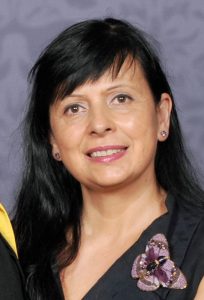History
The hot mineral springs for which Dobrinishte is famous are the reason for life in this god-blessed place for thousands of years. In 1987 archaeological excavations are being carried out in the land of Dobrinishte. The archaeological findings found substantiate the hypothesis that a settlement in this place arose at the end of the first half of the 6th century BC. The population is of Thracian origin, probably from the Kikoni tribe. The Kikons have lived in the lands between the Maritsa and Mesta rivers since the end of the second and first millennium BC. They are mentioned in the legendary “Iliad” and “Odyssey” as allies of the Trojans in the epic Trojan War /XIII century BC/; they are also mentioned by Ovid in his work “Metamorphoses”.
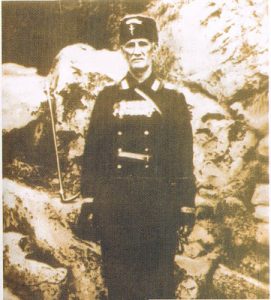
An interesting aspect of the Thracian theme is connected with the name of Mount Bezbog. According to the old speakers in Dobrinishte, Bezbog is pronounced as “Besibog”, which brings to mind the name of the Thracian besi. The Besi are a noble family of the satri tribe. They are known as an elevated society of priests and diviners, as guardians of the temple of Dionysus in the Rhodopes. By nature they were rebellious and free, because they lived on high mountains with inaccessible forests and snowy peaks. The satras themselves are located in the area of Bozdag Mountain /Falacro – today in Greece/, along which the Mesta River descends to the White Sea.
With the advance of the Romans on the Balkan Peninsula at the end of the first century BC, the Besi were pushed out of their traditional settlements. The Roman historian Pliny the Elder /23-79/ mentions their settlements between the rivers Struma and Mesta. In the context of these considerations, we mention the research of the Thracian sanctuaries along the valley of the Retiže River, which rushes headlong from the granite heart of Pirin to the Mesta River, and about the holy place in itself – Lake Popovo.
The Roman era in the valley between the three mountains remains in history with the construction of solid stone foothill roads, Roman baths near the hot springs, with Nicopolis ad Nestum – the city of victory near Mesta, with the penetration of Christianity.
Christianity in the valley of Mesta and Maritsa was founded with the “evangelistic” journey of the apostle Paul in 54. In the Razlog valley, you can visit the ruins of early Christian temples: “St. Nikola” /between Bansko and Dobrinishte/, “St. Ivan”, “St. Georgi” and “Shipotsko” in Bansko, the churches in the ancient city of Nikopolis ad Nestum near Garmen.
The lands between the Pirin, Rila and Rhodopes mountains became part of the Bulgarian state under Khan Krum’s successors in the middle of the 9th century, when most likely the local people were already permanently Christianized. The remains of several settlements around Dobrinishte, formed around Christian temples, are known from the Middle Ages: Gumnishte; The drain with remains of the church of St. Nicholas”; Tomato; Beldo with remains of the church “St. Spas”; Kosoldo with remains of the church “St. Marina”.
In written sources, the settlement of Dobrinishte is mentioned for the first time under the form Dobrinishta, Dobronishte in the Ottoman tax registers from the first half of the 17th century. The settlement has a variable number of population and despite the violent Mohammedanization, the increase was positive. Since then, a number of Dobrinish families have been known that still exist today: Topuzov, Panchov, Pumpalov, Vardarinkov, Rusini, Vlasov, Shopov, Damyanov, Galchov, Simidchiev, Bachev, Dramenov, Kaferinov, Popadiin, Parapunov, Munin, Jolev, Pchelini, etc. . Bulgarians also coexist with other ethnic and religious communities: Muslims, Gypsies, Greeks, etc. Dobrinishte emerges as a typical colorful village from the Balkans.
In the 17th century Dobrinishte is starting to prosper. Cattle breeding was a traditional livelihood of the people. In the summer, the flocks of over 500 sheep and goats grazed in the lush Pirin meadows, and when winter knocked on the door, they went down to the Aegean Sea. Cultivable land was scarce and men often left their hometown seasonally to work in the rich fields of Sersko and Dramsko. Getting to know the Balkan roads, the first merchants appeared among the inhabitants. In 1762 Paisiy Hilendarski, born in Bansko, wrote the famous “Slavic Bulgarian History”, which marked the beginning of the Bulgarian awakening, the desire for enlightenment, emancipation and self-confidence not only among the Balkan peoples, but also further afield.
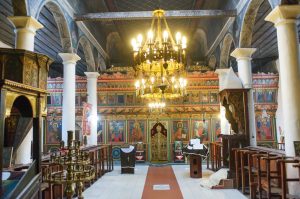
The church, as the center of Bulgaria, turns out to be the center of public life. The revival of the Bulgarian spirit finds expression in the desire to build a new temple – majestic, bright and picturesque. In 1835, Dobrinishteni were in tune with the dictates of the times. the construction of the church “St. St. Peter and Paul”. The next generation of patriots takes up the organization of education and enlightenment in the place of birth. This happened around 1858. The first teachers were artisans and priests. Among them are the shoemaker Spas Bonkin, priest Tsvetko, priest Mihail. Daskalis also came from the neighboring villages, and their salary was given by the local municipality.
There are not a few people from Dobrinishte who dedicate their lives to Bulgaria. We could not list them here – this has already been done by Dobrinishte local historian Todor Petlov in his book “Dobrinishte”. It is true that in the fire of uprisings and wars, Dobrinishte had a tragic part: it was repeatedly set on fire and razed to the ground, it gave numerous peaceful victims, but it rose again from the ashes. The last pogrom was during the ill-fated Inter-Allied War in 1913, when the Greek troops entered the village, burned down the houses and even attacked the holy place – the old church “Assumption of the Virgin Mary”, from which only the icon of the Holy Virgin Vrataritsa survived miraculously. Evidence of this is a built-in plaque in the apse, which has been preserved.
It has been written and known about Grigor Kostov Matsin, a participant in Hristo Botev’s and Philip Totyu’s squads. It is a well-known fact that during the Second Tour of Bulgaria, Vasil Levski founded a secret revolutionary committee in the Razlozhka valley, in Mehomiya, in the house of Kipre Maksev in the summer of 1869. The founders were intelligent, brave and active men who in a short time created a network of co-conspirators throughout the surrounding area. In Dobrinishte, committee work is organized by Kuzman Poptomov, Yote Prtev, Georgi Temelkov, Lazar Prodanov. In preparation for the April Uprising, the valley was included in the Fourth Panagyur Revolutionary District. The insurgent wave of the spring of 1876. for a number of reasons it does not reach the Reason, but the seriousness of the committee’s work and the dedication of the local people speak for the following events:
- The Russian-Turkish war of liberation /1877-1878/ and organization of the Bulgarian militia, which included Georgi Temelkov and other well-wishers. He is one of the defenders of the Samara flag in the Shipchen epic. A memorial plaque to Georgi Temelkov was placed today in the city park.
- The Kresna-Razlozh uprising of 1878. as a protest against the decisions of the Berlin Congress and leaving Macedonia and Odrin Thrace within the Ottoman Empire.
- The struggles against the Greek bishops, for ecclesiastical independence and the inclusion of the valley of Mesta to the diocese of the Bulgarian Exarchy.
- Ilindensko-Preobrazhensko-Krastovdensko Uprising of 1903.
- The creation of a VMRO committee by Gotse Delchev
- The Balkan Wars /1912-1913/ and the First World War /1914-1918/
In Dobrinishte, there is a museum gathering in Ivan Kozarev’s birthplace. In it, the authentic folk costumes, the rich archives on education and the participation in the national liberation movement of the local people are interesting. The history of Dobrinishte is part of the history of Bulgaria.
Sights in Dobrinishte
The tourist information center of Dobrinishte is located in the center of the town in the building of the community center.
What survives and endures through the centuries are spiritual achievements, moral value and moral purity. An exceptional achievement for Dobrinishten was the construction of the church “St. St. app. Peter and Paul” in 1835. Like all temples from the Renaissance era, it is distinguished by its clean silhouette and colorful decoration on the inside. It shows the rich Bulgarian soul – the subtle sense for the beautiful, for the harmony of colors, the longing for freedom and the hope for a future with cloudless blues. The building is large and its construction cost a lot of labor and money to the local community. It is 22 m long, 17.60 m wide. and 5.40m high. The thickness of the walls is 80 cm. The altar apse is 3.60 m wide. and height 9.60m. The church was built by an unknown craftsman, who modestly left only his name on a marble slab above the southern entrance – Usta Georgi. The names of “God’s servants Todor and Lazar Ergini” are also read there. On a second marble slab with the inscription 1865. the names of the donors are immortalized: Yuvan, Savatina, Petre, wife Todora, Marta, Pavlo Gyurchein.
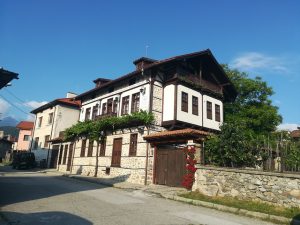
In the temple there is a valuable relic – openwork altar doors from the old church of the Rila Monastery. The icons are the work of Tomas Vishanov Molera and his son Dimitar. One of the most remarkable works of Toma Vishanov, which today can be found in the Permanent Icon Exhibition of the Bansk Art School /in Bansko/, comes precisely from the Dobrinish church. These are the icons distinguished by their artistry and painting: “Baptism of Christ”, “St. John the Baptist” and “Christ the Blesser”. The altar icons in the church belong to Thomas’ son Dimitar. Here is also the icon “St. The Virgin Gatekeeper”, survived the fire of 1913. in the old Assumption Church.
The temple feast is on June 29.
The Assumption Church is in Bunare district. It is close to “St.St. app. Peter and Paul”. It was built on medieval foundations. It is currently fully restored, with a new altar, icons and frescoes. It is not open all the time.
- Other attractions are the church “St. Kozma and Damyan” at the exit from the town in the direction of the Gotse Delchev hut, the monument to Ivan Kozarev, the large park of the town bath, the mascot of the town – Pirincho the bear in the park opposite the community center, the Old Fisherman on the Desilitsa River, the banks of the Desilitsa River.
Festive and festival calendar of Dobrinishte
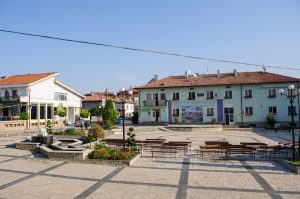
- May 6 – St. George’s Day, when the wrist-melting ritual is performed in the individual hamlets of the town, after which, dressed in the most beautiful traditional costumes, everyone goes to the square for a big St. George dance;
- June 24 – First National Dance Festival AZAT 2023;
- June 29 – St. Peter’s Day, temple holiday of the church “St. app. Peter and Paul”
- July 1, September 1 – “Dobrinish summer” – a traditional festival of self-made ensembles, every Saturday in the square during the summer season;
- August 15 – Dormition of the Virgin Mary, temple holiday of the Dormition of the Blessed Virgin Mary church;
- September 8 – Nativity of the Virgin – Temple holiday of the church in the Obidim monastery;
- September 16 – “Colorful pitcher” – International festival of dance clubs from Bulgaria and the Balkan countries;
- September 22 – Day of the city of Dobrinishte.
Nature and mountain
The greatest value of Dobrinishte is the mineral water. There is a mineral bath built in 1934 in the city. above the captured hot spring. Women’s and men’s wards were built, each with a deep melting pool. Separately, individual tubs are available, which are filled instantly from the spring. In front of the spa there is a fountain from which you can pour yourself water. Its healing properties are aimed at problems of the stomach, bile diseases, ulcers.
Along the Desilitsa river near the city in the direction of Gotse Delchev is the famous silver spring. You will immediately recognize the place from the constant presence of people pouring themselves water.
Dobrinishte is famous for its fishponds for fresh trout. You can visit the old fish pond of Ivan Kozarev or the fish restaurant near the Gotse Delchev hut.
Dobrinishte is the main departure point for the Bezbog park area of the Pirin National Park. From Dobrinishte on a nice asphalt road with a length of 12 km. you get to Gotse Delchev hut. Near it is placed a large granite stone with a commemorative inscription for the voivode and apostle of freedom – Gotse Delchev. A stone fountain with delicious and clear mountain water invites visitors to fill themselves with water for the journey, think about nature and forget about mineral water unnecessarily bottled in plastic.
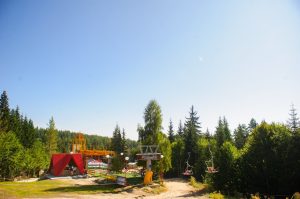 The chairlift from the Gotse Delchev hut to the Bezbog hut operates during the summer season from 8:30am. until 4:30 p.m.
The chairlift from the Gotse Delchev hut to the Bezbog hut operates during the summer season from 8:30am. until 4:30 p.m.
